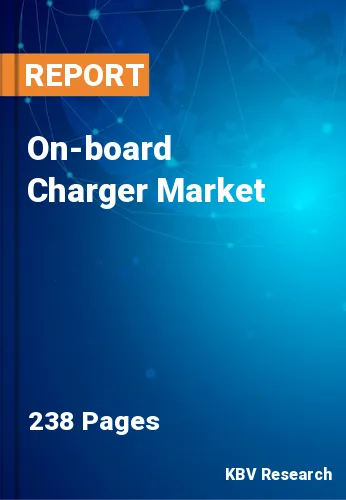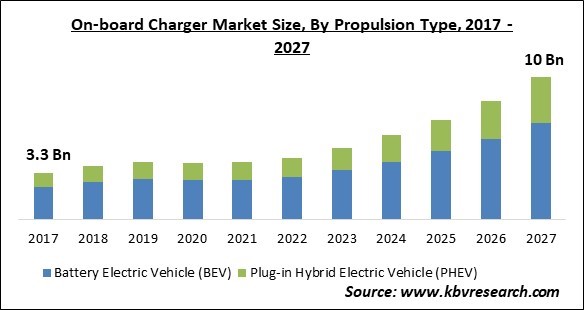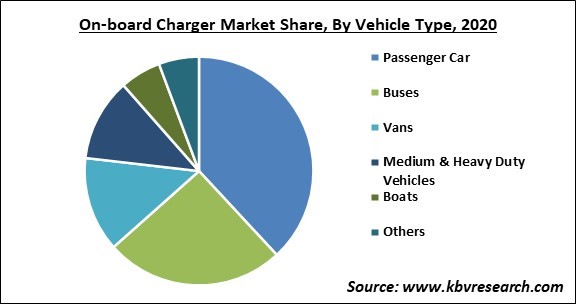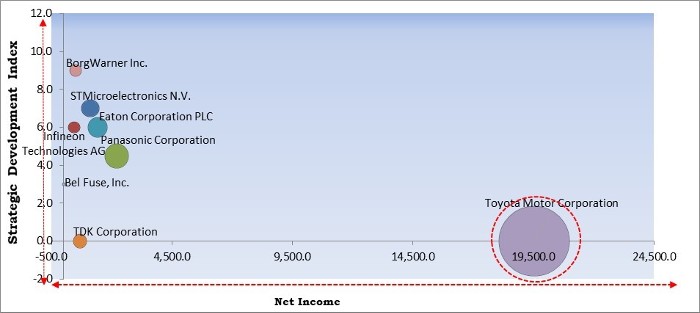
The Global On-Board Charger Market size is expected to reach $10 billion by 2027, rising at a market growth of 16.2% CAGR during the forecast period.
An on-board charger (OBC) is a device that charges the traction battery of an electric vehicle (EV), a hybrid electric vehicle (HEV), or a plug-in hybrid car. The on-board charger of an electric car transforms the grid's AC input to a DC input, which is then used to charge the battery. The electronic components in the on-board charger (OBC) allow the battery to be recharged from the AC mains, whether at home or at private or public charging stations.
Hybrid vehicles have a fossil fuel-powered drivetrain as well as an electric drivetrain, which can be organized in a variety of ways. Mild hybrids, for example, have a smaller battery that is charged by a mix of the ICE and a generator. While the car is slowing down and the motor is acting as a generator, regenerative braking gives some charge to prolong the range. While the vehicle is stationary, PHEVs and BEVs have the ability to plug into the mains grid and recharge the battery.
The on-board charger may charge at either a constant current or a constant voltage, and both modes are simple to use. And each one has its own set of benefits and drawbacks. Constant current charging has a high efficiency and charging speed, but there is a risk of the battery being overcharged at a later stage, reducing its lifespan. When using constant voltage charging, there is a chance that too much current will flow into the battery right away, overheating the battery and shortening its lifespan.
As a result, the charger guarantees that it is charged with a constant current at first, preserving speed & efficiency, and then switches to constant voltage charging when the voltage at both ends of the battery reaches a specified amplitude. This system is known as the charging strategy, and it is the on-board charger's most significant function.

The COVID-19 pandemic had a negative influence on electric vehicle sales in the first half of 2020, which slowed industry growth. The imposition of lockdown and other restrictions has reduced the usage of electric vehicles on road. In addition, the sales of electric vehicles have also declined severely since consumers were only investing in essential products. Nonetheless, governments' efforts, such as increased purchase incentives, lower battery costs, and EV upgrade offers from original equipment manufacturers, created prospects for EV adoption during the pandemic.
However, due to statewide lockdowns imposed in several nations, automotive OEM production facilities were obliged to temporarily shut down all vehicle manufacturing operations. It also caused delays in the development of on-board chargers in terms of production and development. Vaccination initiatives against Covid19 are expected to allow restrictions to be gradually lifted.
The infrastructure for charging electric vehicles is critical for their widespread adoption. Several government projects have been launched around the world to supply electric vehicle charging stations. In addition, several nations are focusing on sustainable development along with minimizing the emission level in the environment. Various governments are working with on-board charger companies to support their plan of establishing electric vehicle transportation system.
Because gasoline is a fossil fuel, it is not a renewable source of energy and will eventually run out. Alternative fuel sources must be developed and used to support sustainable development. This entails the usage of electric vehicles, which do not require the use of gasoline and are more cost effective than traditional automobiles. EVs have a number of advantages, including lower fuel usage (petrol, diesel, and gas) and lower emissions from tailpipes, which are driving up demand around the world. This is likely to increase the need for on-board chargers in electric or plug-in hybrid vehicles in the coming years.
The grid provides AC (alternating current) to major charging stations, which is also found in household outlets. Inside the electric vehicle, on-board chargers convert AC power to DC (Direct Current) power for the battery. This charging procedure, however, is slower than that of DC fast chargers. Because the charging stations convert AC power to DC and transmit DC power directly to the battery, DC fast chargers charge the EV faster.

By propulsion type, the on-board charger market is fragmented into Battery Electric Vehicle (BEV) and Plug-in Hybrid Electric Vehicle (PHEV). The PHEV segment garnered a significant revenue share in the on-board charger market in 2020. Several Plug-in Hybrid Electric Vehicle (PHEV) manufacturers are using on-board chargers with outputs ranging from 3 to 3.7 kW, which is propelling the growth of the segment. On-board chargers are used to charge the batteries in vehicles like the Hyundai Sonata PHEV, Kia K5 PHEV, and Mitsubishi Outlander PHEV. PHEVs are gaining more popularity around the world.
On the basis of vehicle type, the on-board charger market is segmented into Passenger Car, Buses, Vans, Medium & Heavy-Duty Vehicles, Boats and others. The passenger cars segment acquired the highest revenue share in the on-board charger market in 2020 and is estimated to continue this trend over the forecast period. On-board chargers would become more popular as the number of electric passenger cars sold across the world is rising. In addition, the rising disposable income of the consumers is motivating them to adopt EVs and hence, surge the growth of the segment.
Based on power output, the on-board charger market is classified into Less than 11 kW, 11 kW to 22 kW and More than 22 kW. The 11kW to 22 kW segment garnered a significant revenue share in the on-board charger market in 2020. The 11-22 kW chargers are tri-phase AC chargers that take two to four hours to fully charge an electric vehicle. A public charging station is usually a tri-phase AC charger. According to figures published by Transport & Environment, tri-phase AC chargers account for 61% of European public chargers.
| Report Attribute | Details |
|---|---|
| Market size value in 2020 | USD 3.9 Billion |
| Market size forecast in 2027 | USD 10 Billion |
| Base Year | 2020 |
| Historical Period | 2017 to 2019 |
| Forecast Period | 2021 to 2027 |
| Revenue Growth Rate | CAGR of 16.2% from 2021 to 2027 |
| Number of Pages | 238 |
| Number of Tables | 374 |
| Report coverage | Market Trends, Revenue Estimation and Forecast, Segmentation Analysis, Regional and Country Breakdown, Competitive Landscape, Companies Strategic Developments, Company Profiling |
| Segments covered | Propulsion Type, Vehicle Type, Power Output, Region |
| Country scope | US, Canada, Mexico, Germany, UK, France, Russia, Spain, Italy, China, Japan, India, South Korea, Singapore, Malaysia, Brazil, Argentina, UAE, Saudi Arabia, South Africa, Nigeria |
| Growth Drivers |
|
| Restraints |
|
Region-wise, the on-board charger market is evaluated across North America, Europe, Asia Pacific and LAMEA. Asia Pacific emerged as the leading region in the on-board charger market with the maximum revenue share in 2020. Government initiatives to promote electric car sales are increasing in nations like China and India, which is boosting regional market growth. The Chinese government's sales quotas, for example, are one of the primary factors boosting EV on-board charger sales in the country for the years 2019, 2020, and 2021.
Free Valuable Insights: Global On-board Charger Market size to reach USD 10 Billion by 2027

The major strategies followed by the market participants are Partnerships. Based on the Analysis presented in the Toyota Motor Corporation is the major forerunners in the On-Board Charger Market. Companies such as Bel Fuse, Inc., TDK Corporation and Panasonic Corporation are some of the key innovators in the Market.
The market research report covers the analysis of key stake holders of the market. Key companies profiled in the report include Current Ways, Inc., Eaton Corporation PLC, STMicroelectronics N.V., Infineon Technologies AG, Bel Fuse, Inc., TDK Corporation (InvenSense), Toyota Motor Corporation, BorgWarner, Inc., Panasonic Corporation, and AVID Technology Limited.
By Propulsion Type
By Vehicle Type
By Power Output
By Geography
The on-board charger market size is projected to reach USD 10 billion by 2027.
Growing penetration of EVs are driving the market in coming years, however, high deployment of DC fast chargers limited the growth of the market.
Current Ways, Inc., Eaton Corporation PLC, STMicroelectronics N.V., Infineon Technologies AG, Bel Fuse, Inc., TDK Corporation (InvenSense), Toyota Motor Corporation, BorgWarner, Inc., Panasonic Corporation, and AVID Technology Limited.
The Less than 11 kW market acquired maximum revenue share in the Global On-board Charger Market by Power Output 2020, thereby, achieving a market value of $5.3 billion by 2027.
The Buses market shows highest growth rate of 15.3% during (2021 - 2027).
The Asia Pacific market is the fastest growing region in the Global On-board Charger Market by Region 2020, and would continue to be a dominant market till 2027.
Our team of dedicated experts can provide you with attractive expansion opportunities for your business.
